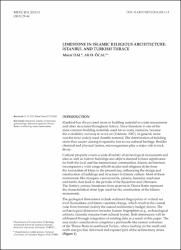| dc.contributor.author | Dal, Murat | |
| dc.contributor.author | Öcal, Ali D. | |
| dc.date.accessioned | 2021-12-12T16:51:21Z | |
| dc.date.available | 2021-12-12T16:51:21Z | |
| dc.date.issued | 2013 | |
| dc.identifier.issn | 0258-5316 | |
| dc.identifier.uri | https://app.trdizin.gov.tr/makale/TWpJMU5EVTRPQT09 | |
| dc.identifier.uri | https://hdl.handle.net/20.500.11857/2536 | |
| dc.description.abstract | Bu çalışmada, İstanbul ve Trakya'daki Türk İslam mimarisinde kullanılan kireçtaşının litolojik özellikleri ile taş bozunmalarının değerlendirilmesi ve korunmasıyla ilgili bazı öneriler üzerinde durulmuştur. Makalede, Trakya'da yaygın olarak kullanılan kireçtaşının davranışını karakterize etmek için disiplinlerarası bir yaklaşım sunulmuştur. Araştırmada özellikle başta Doğu Trakya Havza'sında farklı kireçtaşı ocaklarından alınarak geleneksel yapıların yapımında kullanılmış olan yapı taşlarının paleontolojik yapısı incelenerek fosillerin saptanmasıyla eski jeolojik dönemlerdeki yaşam biçimleri incelenmiştir. Günümüzde, kireçtaşlarının ayrışmaya karşı tepkilerinin tam olarak bilinmesi, anıtların korunmasıyla ilgili çalışmalarda en önemli veri olarak değerlendirilmektedir. Ortamdaki karmaşık kimyasal, mineralojik, biyolojik verilere paleontolojik parametrelerin de eklenmesiyle, kültür varlıkları geri dönüşü olmayan bir bozunma sürecine girmektedirler | en_US |
| dc.description.abstract | Mankind has always used stone as building material to create monuments and other structures throughout history. Since limestone is one of the most common building materials used for so many centuries, because the availability and easy to work on (Yıldırım, 2007). In general, stone was the most widely used durable material. The deterioration of building stone thus causes causing irreparable loss to our cultural heritage. Besides chemical and physical factors, microorganisms play a major role in rock decay. Cultural property covers a wide diversity of archeological monuments and sites as well as historic buildings and objects deemed to have significance for both the local and the international communities. Islamic architecture encompasses a wide range of both secular and religious styles from the foundation of Islam to the present day, influencing the design and construction of buildings and structures in Islamic culture. Most of these monuments like mosques, caravanserais, palaces, hamams, madrasas and tombs date back to the periods of the Byzantine and Ottomans. The Tertiary porous limestones from quarries in Thrace Basin represent the characteristical stone type used for the construction of the Islamic monuments. The geological dimensions include sediment-fingerprints of vertical sea level fluctuations and lateral coastline change, which result in the coastal zone from internal (mainly the coastal sedimentary budget) forces. The archaeological dimension includes human fingerprints (e.g., archaeological artifacts, faunistic remains from cultural layers). Both dimensions will be addressed through integration of existing data as a result of this paper. The area under consideration comprises a panhandle-like eastern extension of the Thrace Basin in northwest Turkey, where faulting on the south and north margins has deformed and exposed part of the sedimentary strata (Figure 1). Limestone is one of the most commonly found stones in building construction in Turkey is due to its ability to be cut and shaped easily, its "warm" colour and its abundance. Whole structures such as mosques, castles, palaces and fortresses were built only with limestone blocks or limestone pieces combined with other types of stone. Although various types of stones have been used as a building material for at least 10.000 years in Anatolia, carbonate rocks especially limestone had been extensively used as building stone material because of their well quality and availability in İstanbul. In general, limestone is a stone that is composed of calcium carbonate and crystalline limestone, which consists of minerals of calcite and aragonite. They are formed by inorganic chemical precipitation and/or with the contribution of organisms and organic processes (Küçükkaya, 2003). Pure Limestone contains % 56 CaO and % 44 CO2. Many Islamic monuments in İstanbul and Turkish Thrace are seriously in danger by damage and, as a result, are in need of intervention. Stone weathering represents a significant reason of damage. Air pollution as a consequence of the rapid expansion of İstanbul and rising water table in combination with increasing water pollution due to insufficient or leaking sewage system are considered as important weathering factors. The size and type of fossil remnants in sedimentary rocks have been affected to the selection process of well quality stone building material (Turgut, Gökselin, 2000). | en_US |
| dc.language.iso | eng | en_US |
| dc.relation.ispartof | Orta Doğu Teknik Üniversitesi Mimarlık Fakültesi Dergisi | en_US |
| dc.rights | info:eu-repo/semantics/openAccess | en_US |
| dc.subject | Mimarlık | en_US |
| dc.title | LIMESTONE IN ISLAMIC RELIGIOUS ARCHITECTURE: İSTANBUL AND TURKISH THRACE | en_US |
| dc.title.alternative | İSLAM DİNİ MİMARİSİNDE KİREÇTAŞI: İSTANBUL VE TÜRKİYE TRAKYASINDAN ÖRNEKLER | en_US |
| dc.type | article | |
| dc.department | Meslek Yüksekokulları, Teknik Bilimler Meslek Yüksekokulu, İnşaat Bölümü | |
| dc.identifier.volume | 30 | en_US |
| dc.identifier.startpage | 29 | en_US |
| dc.identifier.issue | 1 | en_US |
| dc.identifier.endpage | 44 | en_US |
| dc.relation.publicationcategory | Makale - Ulusal Hakemli Dergi - Kurum Öğretim Elemanı | en_US |



















